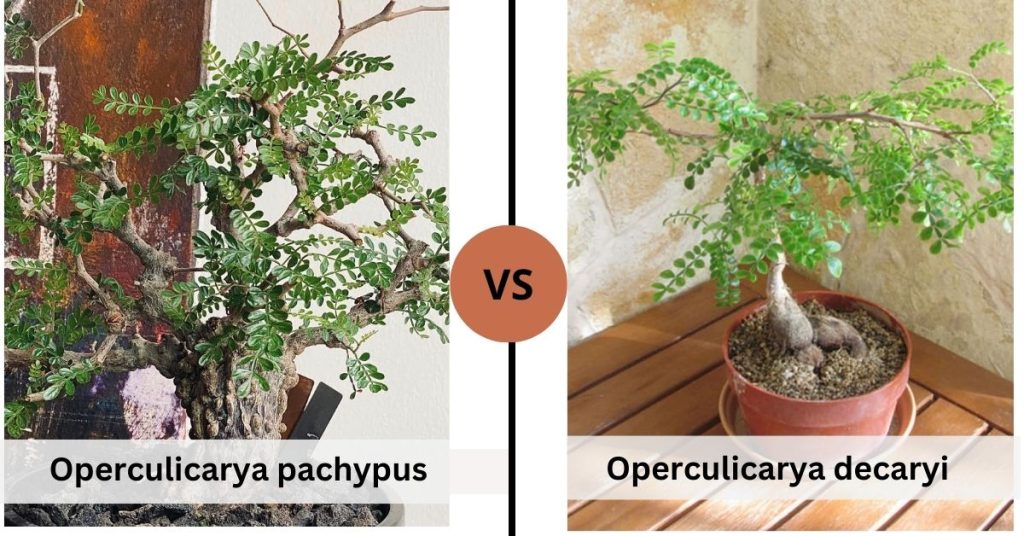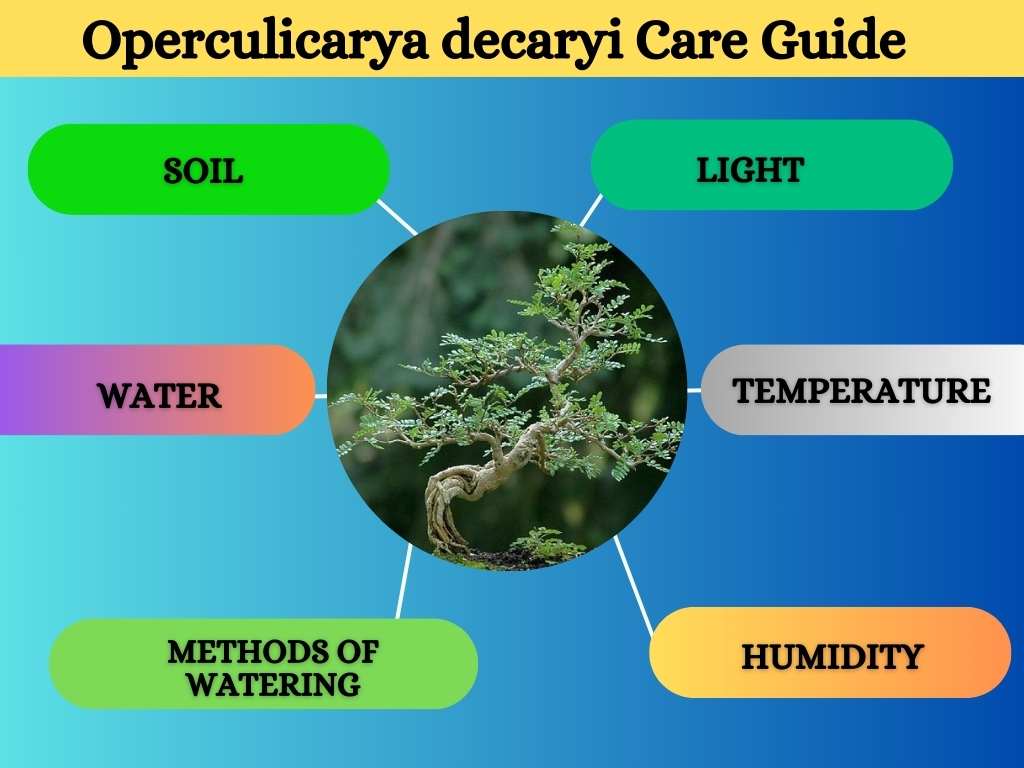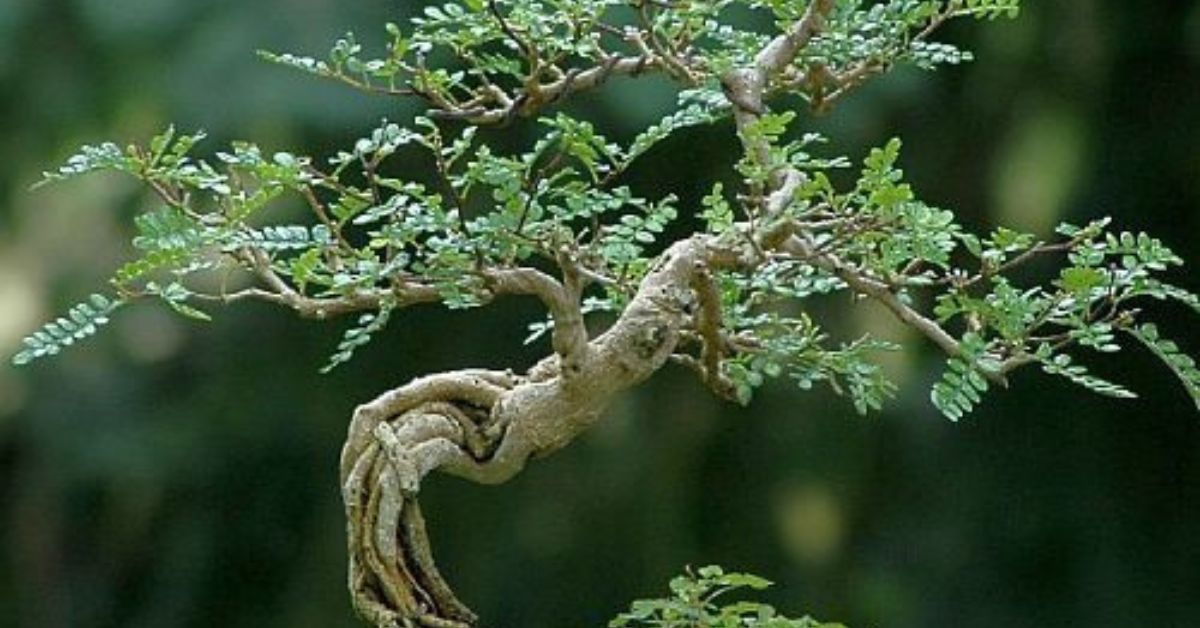The Operculicarya decaryi, commonly known as the Elephant tree, is a fascinating plant that captures the imagination with its unique appearance and intriguing name. The Elephant tree is highly valued for its striking appearance and is often cultivated for ornaments. Its popularity stems from its ability to thrive indoors and outdoors, making it an excellent choice for beginners and experienced plant owners. In this article, we will delve into the care and propagation of the Operculicarya decaryi, providing you with all the necessary information to grow and maintain this stunning plant.

Origin
This succulent tree is native to Madagascar, precisely the Toliara province of southwest Madagascar.
Why is it Called so?
Also referred to as the “Elephant foot tree” or “Elephant plant,” it gets its name due to the bulbous, swollen base of its stem, which resembles an elephant’s foot.
Preferred for Foliage or Flower?
Flower being inconspicuous, foliage and its unique trunk beholds the preference. The caudiciform, or twisted, knobby trunk, bears overarching branches that support a canopy of small, glossy, spherical, dark-green leaves.
Indoor or Outdoor?
Can be grown in both indoor and outdoor settings. But make sure to provide indoor plants with bright indirect light. In addition, it’s critical to prevent overwatering and maintain adequate air circulation
Operculicarya decaryi Growing Habits
Within their natural habitat, the trees reach heights of thirty feet (9 meters) and diameters of three feet (1 meter) for their trunks. Cultivated trees, however, remain much shorter.
One may even cultivate a bonsai elephant tree. This is a “natural” bonsai plant. It grows a big, fat trunk swiftly, and its roots expand into strange, twisted shapes.
Is it suitable for First-time Plant Owners?
With its unique and instantly striking visual, its reputation relies on its one-of-a-kind, bonsai-like image. This aesthetic appeal alongside its low maintenance requirements makes it a popular choice among both experienced plant enthusiasts and beginners. Its adaptability and resilience make it a suitable choice for first-time plant owners looking to enhance their home decor with a touch of nature.
Elephant Tree Plant Characteristics
Roots
The Operculicarya decaryi possesses a well-developed, fibrous root system that aids in anchoring the plant and absorbing essential nutrients from the soil. These roots ensure the plant’s stability and play a crucial role in its overall health and growth.
Stem
One of the most distinctive features of the Elephant tree is its thick, swollen stem that resembles an elephant’s foot. This unique adaptation allows the plant to store water, making it highly resistant to drought conditions. The stem is typically a grayish-brown color and may showcase shallow wrinkles and fissures, further enhancing its resemblance to an elephant’s skin.
Leaves
The leaves of Operculicarya decaryi are delicate and compound, consisting of multiple leaflets that offer a feathery appearance. These leaflets are usually bright green in color and are held on slender stalks. The foliage adds an ethereal beauty to the plant, creating a captivating visual display.
Flowers
While the Operculicarya decaryi does produce flowers, they are relatively inconspicuous and not the primary attraction of the plant. The small white or yellowish flowers bloom in clusters and are most prevalent during the summer months. Although not particularly showy, the flowers add a touch of elegance to the overall aesthetic of the tree.
Fruits
Following the blooming of the flowers, the Elephant tree may produce small, spherical fruits. These fruits are typically green, turning reddish-brown as they mature. While not particularly significant for ornamental purposes, the fruits contribute to the plant’s lifecycle and ecosystem.
Botanical Classification
| Kingdom | Plantae |
| Order | Sapindales |
| Family | Anacardiaceae |
| Sub-family | Spondiadoideae |
| Genus | Operculicarya |
| Species | Decaryi |
USDA Growing Zone
The Elephant Plant thrives in zones 9-11. These areas of the U.S. are warm in the summer and mild in the winter, with average minimum temperatures ranging from 20-30°F for Zone 9, 30-40°F for Zone 10, and above 40°F for Zone 11. In general, freezes in these areas are rare, and daytime temperatures are warm year-round.
Operculicarya decaryi Special Features
Operculicarya decaryi, is a botanical masterpiece adorned with features that paint a canvas of survival in the harshest of terrains.
· Top of Form
· Bottle-shaped trunk cradles life in drought’s embrace
· Succulent leaves that she in the dry season to save water
· Adaptive features in arid realms
· Slow growth speaks volumes of its resilient nature
· Drought Resistance
Operculicarya pachypus vs decaryi

| Operculicarya pachypus | Operculicarya decaryi |
| Compact and bushy | Taller and more tree-like |
| Smaller leaves | Larger leaves |
| Rounded base | Distinctively swollen base |
| Native to arid regions of Madagascar | Native to southwest of Madagascar |
Is Operculicarya decaryi Toxic?
The Elephant tree, Operculicarya decaryi, is not known to be toxic to humans or pets. However, it is always important to practice caution when handling any plant, especially if you have allergies or sensitivities. If you suspect any adverse reactions after contact with the plant, it is recommended to seek medical advice.
General Overview of Elephant Plant
| Characteristics | Description |
| Common name | Elephant Plant |
| Scientific name | Operculicarya decaryi |
| Other name | Jabily, Madagascar ocotillo |
| Origin | South Western region of Madagascar |
| Preferred for | Foliage, Preferred as bonsai for its unique trunk features |
| Is it rare? | Generally not considered as rare. |
| Distribution Area | Worldwide in xerophyte thickets and forests, endemic to S and SW Madagascar |
| Indoor/Outdoor | Suitable for both Indoors and Outdoors. |
| Growing places | As |
| Growth rate | Trunks grow up to 1 meter in thickness |
| Height | Upto 9 meters |
| Width | Trunks grow up to 1 meter in thickness |
| Suitable for beginners | Trunks grow upto 1 meter in thickness |
Operculicarya decaryi Plant Care
| Care aspects | Details |
| Light | Bright, Indirect light, 4 to 6 hours of daily sunlight |
| Temperature | Minimum 30°F, Ideal(65°F and 85°F) |
| Soil | Mixture of cactus potting mix, perlite, and sandy soil works well. |
| Watering | Water once the top inch of soil feels dry, check for the drainage |
| Fertilizer | Report if the plant outgrows its container or the soil becomes compacted. Use fresh succulent mix. |
| Potting and Repotting | A mixture of cactus potting mix, perlite, and sandy soil works well. |
| Training and Pruning | Prune to maintain shape and control size. Trim leggy or damaged stems. |
Operculicarya decaryi care guide
Light
The Operculicarya decaryi thrives in bright and indirect sunlight. Ideally, it should receive at least 4 to 6 hours of sunlight every day. However, it is important to protect the plant from intense or direct sunlight, as this can lead to leaf burn or sun damage. Finding the right balance is essential for the plant’s health and overall growth.
Temperature
The ideal temperature range for Operculicarya decaryi is between 65°F and 85°F (18°C and 29°C). It can tolerate slightly lower temperatures but should be protected from freezing conditions. In winter, it is advisable to bring the plant indoors or provide adequate shelter to prevent cold damage.

Soil
When it comes to soil, the Elephant tree prefers a well-draining mixture that replicates its natural habitat. A combination of succulent or cactus potting mix, perlite, and sandy soil can create an optimal growing medium. The pH level should be slightly acidic to neutral (around 6.0 to 7.0), ensuring the proper absorption of nutrients.
Water
The watering requirements of Operculicarya decaryi vary depending on the season and climate. During the active growing season, it is important to water the plant thoroughly, allowing the water to drain out completely. Once the top inch of soil feels dry, it is time to water again. In winter, reduce watering frequency and ensure the soil is almost fully dry before watering.
Methods of watering
Misting: Use a spray bottle to mist the leaves occasionally, especially during dry seasons or in environments with low humidity. This helps to mimic the plant’s natural habitat and prevents the leaves from becoming too dry
Pebble Tray Method: You can create a pebble tray by placing a saucer filled with water and pebbles underneath the pot. As the water evaporates, it increases the humidity around the plant.
Humidifier: Using a humidifier in the vicinity can provide a consistent humidity level.
Humidity
Operculicarya decaryi thrives in low to moderate humidity levels. It is adaptable to dry air conditions and can withstand fluctuations in humidity. However, it is advisable to provide some level of humidity, especially during drier seasons or in indoor environments with central heating or cooling systems.
Fertilizer
Fertilizing your Elephant tree can help promote healthy growth and overall vitality. During the active growing season, apply a balanced, water-soluble fertilizer diluted to half the recommended strength every four to six weeks. Avoid fertilizing in winter when the plant is in its dormant phase.
Potting and Repotting
Operculicarya decaryi prefers being slightly root-bound, so repotting is not necessary frequently. Only repot the plant when it outgrows its current pot or when the soil becomes overly compacted. When repotting, choose a pot that is slightly larger than the previous one, and ensure it has drainage holes to prevent waterlogged soil.
Training and Pruning
The Elephant tree can be trained and pruned to maintain a desired shape or size. Pruning is best performed during the active growing season, allowing the plant to recover effectively. You can remove any dead, damaged, or overcrowded branches to enhance the overall appearance and encourage healthy growth.
Dormancy
If the temperature falls below fifty degrees Fahrenheit (10°C), bring any indoor elephant tree you may have outside inside the house. Your operculicarya decaryi will fall dormant throughout the winter. As the plant enters dormancy, you can also see some of its leaves falling off or changing to a deeper red or brownish hue.
Operculicarya decaryi Bonsai Care
Encourage Healthy development: By providing it with all the essentials soil, light, water fertilizer, and other additional requirements which will encourage new development and make the structure more compact and full.
Size Control: Pruning is essential to keep your Operculicarya Decaryi bonsai from growing too large for its container.
Aesthetic Enhancement: You may create a balanced and aesthetically beautiful shape for your bonsai by carefully cutting its branches and leaves. This will improve the bonsai’s overall aesthetic appeal.
Disease Prevention: By quickly eliminating unhealthy or dead branches, pruning helps stop the spread of disease and helps to avoid future infestations by fungus and pests.
Use Proper Tools: To improve accuracy and reduce stress on the tree, use clean, sharp instruments while trimming. A bonsai with the right equipment is more visually appealing and healthier.
Seasonal Pruning: Prune your Elephant Tree Bonsai at the appropriate times, respecting the natural growth cycles and maximizing the benefits of this essential care practice.
Operculicarya decaryi Propagation
1. Cutting
Choose a healthy stem section with at least three to four leaf nodes.
Allow the cutting to dry for a few days to prevent excessive moisture.
Plant the cutting in well-draining soil, ensuring at least one or two leaf nodes are below the soil level.
Mist the cutting lightly and cover it with a plastic bag to create a humid environment.
Place the cutting in a warm location with indirect light.
Keep the soil moist but not overly saturated.
After a few weeks, the cutting should develop roots and can be gradually acclimated to normal growing conditions.

2. Grafting
Select a healthy rootstock and a compatible scion (typically a small stem section without leaves).
Make a clean, diagonal cut on both the rootstock and scion.
Align the two cut surfaces, ensuring they fit snugly together.
Secure the graft with grafting tape or a similar plant tie.
Place the grafted plant in a warm and bright location, but protect it from direct sunlight.
Monitor the graft closely and ensure it remains healthy and firmly attached.
Once the graft is established, gradually expose it to normal growing conditions.
3. Seeds
Collect ripe seeds from mature Elephant tree fruits.
Clean the seeds thoroughly and soak them in water for 24 hours.
Sow the seeds in a well-draining soil mixture, pressing them gently into the soil surface.
Cover the pot or tray with a clear plastic cover or a plastic bag to create a mini greenhouse effect.
Place the seeds in a warm location with indirect light.
Keep the soil lightly moist, ensuring it does not become waterlogged.
Germination can take several weeks or even months, so patience is required.
Price
The price of Operculicarya decaryi can vary depending on factors such as plant size, availability, and location. In the United States, you can expect to find small to medium-sized Elephant trees ranging from $20 to $50. Special nurseries, botanical gardens, or online retailers may offer larger specimens at a higher cost. Some recommended places to buy Operculicarya decaryi include succulent nurseries, specialized cactus and succulent shows, and reputable online succulent retailers.
Common Problems
1. Spider mites: These microscopic leaf parasites like warm, dry environments. Use appropriate misting and watering to combat them. Use neem oil or insecticidal soap if suspicions are aroused.
2. Mealybugs: These soft-bodied sap-suckers feed black mould and draw ants. Keep your bonsai clean and use systemic pesticides to fight pests, or use cotton swabs soaked in rubbing alcohol for delicate removal.
3. Root rot: A typical problem associated with inadequate drainage and overwatering is root rot. Select a soil that drains well, make sure the pot has enough drainage, and take quick action to alleviate any symptoms by repotting and pruning any impacted roots.
4. Leaf Spot: An ugly fungal ailment that results in patches. Proper spacing will encourage air circulation, and if fungus is found, it may be treated with fungicide and diseased leaves pruned.
Pros and Cons
| Pros | Cons |
| Unique and captivating appearance | Slow establishment |
| Adaptable to a wide range of growing conditions | Prone to overwatering |
| Can be trained into bonsai form for added aesthetic appeal | Growth rate can vary, requiring patience for optimal results |
| Low-maintenance once established | May require additional measures to control pests and diseases |
Final Verdict
From its captivating bottle-shaped trunk, reminiscent of an elephant’s foot, to the delicate, feathery leaves that sway gracefully, the Elephant tree brings a touch of the extraordinary to your botanical collection. Whether you’re cultivating it indoors or embracing the challenge of an outdoor bonsai, this plant weaves a story of survival and beauty.
While you embrace it remember to prune with precision, nurture with care, and watch as your Elephant tree becomes a living masterpiece.
The allure of this unique succulent lies not just in its physical beauty but in the lessons it imparts – resilience, patience, and the art of adapting to diverse environments. So, let the Elephant tree find its place in your botanical haven, and may your journey with this extraordinary plant be as enchanting as the Elephant tree itself.
FAQS
1. Is Operculicarya decaryi male or female?
Operculicarya decaryi is a monoecious plant, which means it has both male and female reproductive organs on the same plant. This allows for self-pollination and the production of viable seeds.
2. How big is the Operculicarya decaryi?
The size of an Operculicarya decaryi can vary depending on various factors, including age and growth conditions. Generally, mature Elephant trees can reach a height of around 7 to 10 feet (2 to 3 meters) and develop a canopy with a similar width.
3. How do you prune Operculicarya?
Pruning Operculicarya decaryi is essential to maintain its shape and health. Begin by removing any dead, damaged, or overcrowded branches. You can also prune to control the overall size and shape of the plant. When pruning, always use clean and sharp tools to prevent any spread of diseases. Pruning is best performed during the active growing season, as the plant can recover more effectively during this period.
References
1. https://floraliving.co/operculicarya-decaryi/
3. https://smartgardenguide.com/
4. https://www.epicgardening.com/

